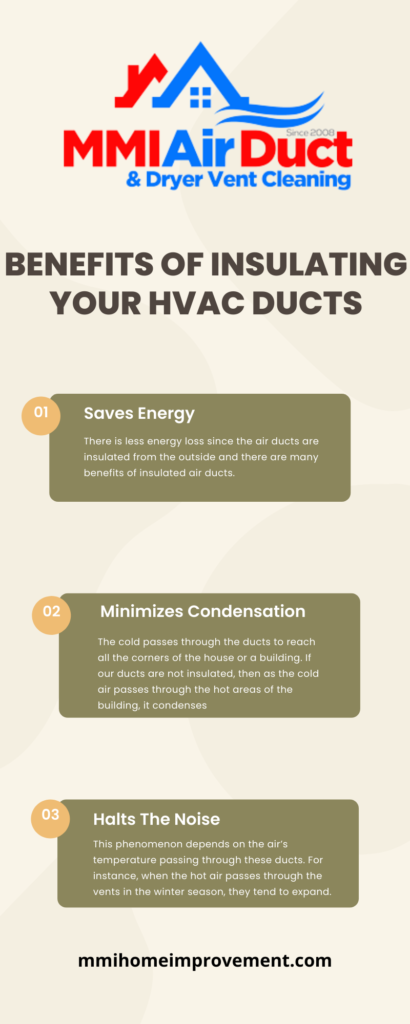Insulating your HVAC ducts is vital as it ensures that no energy is lost uselessly. Moreover, it protects your duct network. To insulate HVAC ducts, you do not need any experts or expertise in particular. You only need some equipment and tools to insulate HVAC ducts. This article will guide you about the benefits of insulation and how to insulate your vents at home.
Benefits Of Insulating Your HVAC Ducts:
1. Saves Energy:
There is less energy loss since the air ducts are insulated from the outside and there are many benefits of insulated air ducts. Additionally, the air temperature does not drop or rise as it moves through the channel across the house. Without insulation, as the air travels through the ducts, it loses energy in dissipation.
Therefore, the central unit must work harder to compensate for the energy loss. Consequently, this puts strain on the system. The system, in turn, uses more energy. Thus we can say that insulation saves extra energy. It allows the system to utilize that energy in more valuable ways.
2. Minimizes Condensation:
In the case of HVAC, the cold passes through the ducts to reach all the corners of the house or a building. If our ducts are not insulated, then as the cold air passes through the hot areas of the building, it condenses.
Moreover, as the air condenses, it also starts dripping. Due to constant dripping, ducts can become rusted. On the other hand, this unwanted moisture also encourages mold to grow in the ducts and on the surface of ducts.
3. Halts The Noise:
As the ducts are mostly made up of metal, they are more prone to contraction and expansion. This phenomenon depends on the air’s temperature passing through these ducts. For instance, when the hot air passes through the vents in the winter season, they tend to expand.
Once the system has reached its optimal temperature, they tend to shrink. Consequently, it produces noisy sounds of popping and cracking. We should use insulation around our ducts. However, insulation does not diminish this phenomenon. Insulation only buffers the sound produced as a result of the change in the size of ducts.
Other than insulation, cleaning of HVAC ducts is also equally important. If you are a resident of Canton, you can easily search for HVAC Cleaning Canton.

Use the below code to Embed this infographic
How To Insulate Your HVAC Ducts - Step By Step Guide:
There are two ways to insulate HVAC ducts network:
1. Fiberglass Insulation:
What Is Fiberglass, And How Does It Work?
Fiberglass insulation is the most effective insulation of all. Glass is the primary component of fiberglass insulation. It has various benefits.
Firstly, it traps the heat inside the ducts. Secondly, it slows the heat transfer rate between the outer and internal environments. It achieves this by creating packets of air in it. Thirdly and most importantly, it does not cause house fires. Lastly, it saves approximately 40% energy. Overall, it is regarded as the best thermal insulation.
Types Of Equipment Needed:
You would need the following equipment and tools in
- Gloves
- Goggles
- Appropriate clothes, so your skin is not directly exposed
- A dust mask
- Duct tape
- Metallic foil to hold insulation in its place
- Fiberglass insulation. (make sure that you use an R-value equal to 6 or higher than it)
Procedure:
Step no. 1:
Firstly, clean the surface of your duct to clear out all the dust and debris.
Step no. 2:
Secondly, if your previous insulation is in good condition, you can apply duct directly on it. However, if your insulation is wearing off, you need to remove it. Apply the sheet of fiberglass insulation over the vents carefully. You can use adhesive. For instance, one can use fastbond adhesive 49. It is water-based and pressure-sensitive.
Step no. 3:
Thirdly, cut the insulation according to the length and width of the duct. Make sure to cut the insulation a little loosely. In this way, it will not compress the fiberglass.
Step no. 4:
Moving further, now apply the small portions of the duct tape to secure the insulation. To hold the entire insulation together, use a long section of duct tape throughout the vent.
Step no. 5:
Now apply the tape again at the joints. Be careful while you are covering the gaps. You are all set to use your insulated HVAC network.
In case, if you have already insulated your ducts, you need to clean these ducts every now and then. You may need professional cleaners for this. For this purpose, you can search for air duct cleaning Canton to avail cleaning services.
2. Polyurethane Foam Spray Insulation:
Closed-cell spray Polyurethane spray(ccSPF) is also used to insulate the duct network. This spray is ideal for the ducts present in attics and closed places. It protects the ducts in extreme temperatures.
Procedure:
- First of all, you need to make sure that all the ducts are directly in contact with the ceiling. If some vents are lying on the floor, you may want to hang them from the ceiling using cords or straps.
- After that, spray your ccSPF on the ducts. Make sure that you have covered the whole area of the duct. You can customize the depth of the spray on your vent.
Benefits Of ccSPF :
Some of the advantages of ccSPF are listed below
- It mechanically fastens the duct
- Moreover, it mattic-seal all the gaps, joints, and duct connections
- It is ideal for encapsulated duct network
- Lastly and most importantly, it supports higher temperatures and humidity, moisture, and marine climate.

Conclusion:
In conclusion, we can say that insulation of HVAC ducts is essential as it has several advantages. It is safe and healthy. Moreover, it is eco-friendly as it minimizes energy loss. We should always insulate the HVAC ducts network for our benefit.
